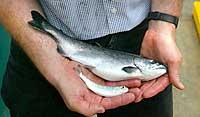 |
||||
Make Way for Frankenfish!What Happens To These Ordinary Salmon If The Genetically Modified Lunkers Ever Get Loose?Time Magazine
Whether served as raw sushi, grilled steak or in thin smoked slices, most of the salmon you eat these days is not the sleek sport fish that has been a favorite of anglers since Izaak Walton but rather a chunky, sluggish creature raised in captivity. Indeed, salmon caught in the wild accounts for less than half of all salmon sold in the U.S. Now gene splicers have cooked up a replacement that sounds like a fish tale: a veritable superfish, one that can grow at least twice as fast, resist disease and outmate competitors. If approved, it could provide protein to millions of people at a time when fish stocks are perilously low. But as you might expect, some critics are carping. They consider the supersalmon a biological time bomb that could destroy the remaining natural salmon populations and wreak other environmental havoc. To them, the supersalmon is nothing less than a "Frankenfish." Unlike other genetically modified foods--so-called Frankenfoods--the supersalmon was born almost accidentally. About 20 years ago, a fish researcher in Newfoundland found that even though his saltwater tank had frozen, the flounder in it survived. Adapted to icy Canadian waters, the fish turned out to have a gene, known in other polar fishes, that produces an anti-freeze protein. While trying to splice this gene into salmon so it too could be grown in colder waters, scientists made a second accidental discovery: they found that while the gene didn't keep the salmon from freezing, a portion of it, when stitched onto a salmon's growth-hormone gene, greatly speeded development--up to five or six times as fast as in the early months and about twice as fast overall. Patenting their discovery, the scientists started a company in Waltham, Mass., called A/F Protein (A/F stands for antifreeze). The company has 10,000 to 20,000 Atlantic supersalmon swimming in
endless circles in 136 tanks at three locations in Canada's Maritime
provinces. The hope is that these fish will soon be producing eggs for
commercial aquaculture not just in Canada but in New Zealand, Chile and
the U.S. as well. By turning to the supersalmon, says Elliot Entis, A/F's
president, fish farmers could double production without doubling costs
because the fish converts food into body mass so much more efficiently
than ordinary salmon. That, he says, would mean "more
fish for more people at a lower price."
|
 In
a fight for survival, the normal Coho salmon lost to the aggressive
genetically modified salmon known as "frankenfish."
In
a fight for survival, the normal Coho salmon lost to the aggressive
genetically modified salmon known as "frankenfish."